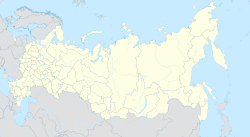Our website is made possible by displaying online advertisements to our visitors.
Please consider supporting us by disabling your ad blocker.
Volgograd
Volgograd
Волгоград | |
|---|---|
Eternal Flame Volgograd Central Embankment | |
| Coordinates: 48°42′31″N 44°30′53″E / 48.70861°N 44.51472°E | |
| Country | Russia |
| Federal subject | Volgograd Oblast[2] |
| Founded | 1589[3] |
| City status since | 1780[1] |
| Government | |
| • Body | City Duma[4] |
| • Head[4] | Vladimir Marchenko[5] |
| Area | |
• Total | 859.35 km2 (331.80 sq mi) |
| Elevation | 80 m (260 ft) |
| Population | |
• Total | 1,021,215 |
• Estimate (2018)[7] | 1,013,533 (−0.8%) |
| • Rank | 12th in 2010 |
| • Density | 1,200/km2 (3,100/sq mi) |
| • Subordinated to | city of oblast significance of Volgograd[2] |
| • Capital of | Volgograd Oblast,[2] city of oblast significance of Volgograd[2] |
| • Urban okrug | Volgograd Urban Okrug[8] |
| • Capital of | Volgograd Urban Okrug[8] |
| Time zone | UTC+3 (MSK |
| Postal code(s)[10] | 400000–400002, 400005–400012, 400015–400017, 400019–400023, 400026, 400029, 400031–400034, 400036, 400038–400040, 400042, 400046, 400048–400055, 400057–400059, 400062–400067, 400069, 400071–400076, 400078–400082, 400084, 400086–400089, 400093, 400094, 400096–400098, 400105, 400107, 400108, 400110–400112, 400117, 400119–400125, 400127, 400131, 400136–400138, 400700, 400880, 400890, 400899, 400921–400942, 400960–400965, 400967, 400970–400979, 400990–400993 |
| Dialing code(s) | +7 8442 |
| OKTMO ID | 18701000001 |
| City Day | Second Sunday of September[1] |
| Website | www |
Volgograd,[a] formerly Tsaritsyn[b] (1589–1925) and Stalingrad[c] (1925–1961), is the largest city and the administrative centre of Volgograd Oblast, Russia. The city lies on the western bank of the Volga, covering an area of 859.4 square kilometres (331.8 square miles), with a population of slightly over one million residents.[11] Volgograd is the 16th-largest city by population size in Russia,[12] the third-largest city of the Southern Federal District, and the fourth-largest city on the Volga.
The city was founded as the fortress of Tsaritsyn in 1589. By the 19th century, Tsaritsyn had become an important river-port and commercial centre, leading to its rapid population growth. In November 1917, at the start of the Russian Civil War, Tsaritsyn came under Bolshevik control. It fell briefly to the White Army in mid-1919 but returned to Bolshevik control in January 1920. In 1925, the city was renamed Stalingrad in honor of Joseph Stalin, who took part in defending the city against the White Army and who then ruled the country. During World War II, Axis forces attacked the city, leading to the Battle of Stalingrad, the largest and bloodiest battle in the history of warfare,[13] from which it received the title of Hero City. In 1961, Nikita Khrushchev's administration renamed the city to Volgograd as part of de-Stalinization. The Soviet victory at Stalingrad is widely held to be the turning point of World War II, leading to the destruction of the German army in the East.
Volgograd today is the site of The Motherland Calls, an 85-metre (279 ft) high statue dedicated to the heroes of the Battle of Stalingrad, which is the tallest statue in Europe, as well as the second tallest statue of a woman in the world. The city has many tourist attractions, such as museums, sandy beaches, and a self-propelled floating church. Volgograd was one of the host cities of the 2018 FIFA World Cup.[14]
- ^ a b c Charter of Volgograd, Preamble
- ^ a b c d Cite error: The named reference
Ref151was invoked but never defined (see the help page). - ^ Энциклопедия Города России. Moscow: Большая Российская Энциклопедия. 2003. pp. 81–83. ISBN 5-7107-7399-9.
- ^ a b Charter of Volgograd, Article 22
- ^ "Руководители". volgadmin.ru. Retrieved January 29, 2023.
- ^ Russian Federal State Statistics Service (2011). Всероссийская перепись населения 2010 года. Том 1 [2010 All-Russian Population Census, vol. 1]. Всероссийская перепись населения 2010 года [2010 All-Russia Population Census] (in Russian). Federal State Statistics Service.
- ^ "26. Численность постоянного населения Российской Федерации по муниципальным образованиям на 1 января 2018 года". Federal State Statistics Service. Retrieved January 23, 2019.
- ^ a b Cite error: The named reference
Ref921was invoked but never defined (see the help page). - ^ "Об исчислении времени". Официальный интернет-портал правовой информации (in Russian). June 3, 2011. Retrieved January 19, 2019.
- ^ Почта России. Информационно-вычислительный центр ОАСУ РПО. (Russian Post). Поиск объектов почтовой связи (Postal Objects Search) (in Russian)
- ^ "RUSSIA: Južnyj Federal'nyj Okrug: Southern Federal District". City Population.de. August 4, 2020. Retrieved October 18, 2020.
- ^ "Оценка численности постоянного населения по субъектам Российской Федерации". Federal State Statistics Service. Retrieved September 1, 2022.
- ^ Davis, Daniel L. (November 28, 2016). "Why Stalingrad Was the Bloodiest Battle of World War II (and Perhaps of All Time)". The National Interest. Retrieved March 17, 2022.
- ^ "World Cup 2018 stadiums: Complete guide to all 12 venues in 11 Russian cities - CBSSports.com", June 27, 2018 "The industrial city of Volgograd ... plays host to the following group stage games: Tunisia vs. England on June 18, Nigeria vs. Iceland on June 22, Saudi Arabia vs. Egypt on June 25 and Japan vs. Poland on June 28."
Cite error: There are <ref group=lower-alpha> tags or {{efn}} templates on this page, but the references will not show without a {{reflist|group=lower-alpha}} template or {{notelist}} template (see the help page).
Previous Page Next Page















